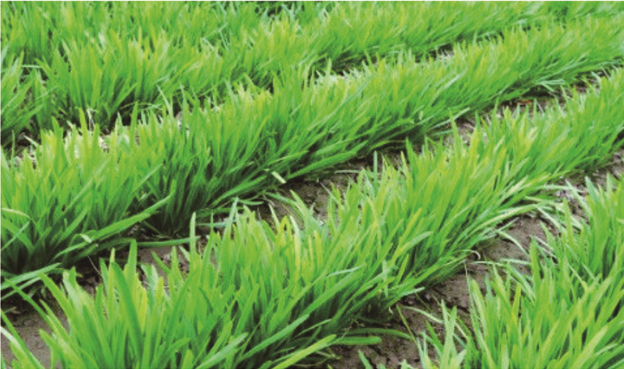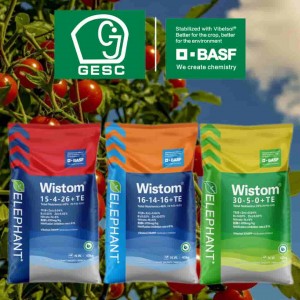Symptoms of Nitrogen Deficiency in Leeks:
When leeks lack nitrogen, they exhibit symptoms such as stunted growth, slow development, fewer leaves than normal, and a pale yellow color, which first appears on older leaves. Nitrogen is an essential nutrient for plants, and its deficiency can lead to a lower protein content in the reproductive organs, causing early flowering.
Causes of Nitrogen Deficiency:
This deficiency may occur due to low nitrogen content in the soil, especially in sandy soils, where nitrogen is easily lost through leaching, volatilization, or drainage. Soils with low organic matter, poor structure, and intense leaching, such as newly cultivated red or yellow soils, are prone to nitrogen deficiency. Additionally, poor soil structure can cause waterlogging during rainy seasons, hindering root absorption. Insufficient or untimely fertilization, or the excessive use of raw organic fertilizers, can also lead to nitrogen deficiency, as microorganisms compete for nitrogen sources.
Prevention and Remedial Measures for Nitrogen Deficiency in Leeks:
To prevent nitrogen deficiency, it is essential to apply sufficient base fertilizer. When leek seedlings reach 10-15 cm in height, apply about 20 kg of ammonium sulfate per acre as a top dressing. During the peak growth period, apply 15-20 kg of ammonium sulfate per acre 2-3 times based on the plant's needs. After harvesting leeks, apply 15-20 kg of ammonium sulfate compound fertilizer per acre 2-3 days later. If nitrogen deficiency is detected, quickly apply fast-acting nitrogen fertilizers, such as 10-15 kg of urea per acre, by making shallow grooves near the plants for application.

Causes of Phosphorus Deficiency in Leeks
Insufficient available phosphorus in the soil due to a lack of organic matter.In soils, phosphorus combines with iron and aluminum, forming insoluble compounds and becoming fixed.In alkaline soils or soils with excessive lime application, phosphorus binds with calcium, reducing its availability.Drought and water deficiency in the soil hinder phosphorus diffusion to the root system.Prolonged cold temperatures and low light conditions can cause poor root development in fruit trees, affecting normal phosphorus absorption.
Over-application of nitrogen and insufficient phosphorus application can lead to nutrient imbalances.
Preventive and Remedial Measures for Phosphorus Deficiency in Leeks
Apply sufficient phosphorus fertilizer during the base fertilization stage, and later spray 0.3%-0.4% potassium hydrogen phosphate solution on the leaves 3-4 times.Alleviate deficiency through organic fertilizer application or by using chemical fertilizers such as urea and super phosphate to help restore normal growth

Symptoms of Potassium Deficiency in Leeks
When leeks lack potassium, they show signs of leaf-edge burn. This burn initially appears on older leaves, with yellow halos at the tips and edges, which then turn yellow and die off. The plants grow slowly, the roots develop poorly, and the stems become fragile, often leading to lodging. The seeds are small and shriveled, and the plants have low resistance to diseases.
Causes of Potassium Deficiency in Leeks
Insufficient potassium supply in the soil: soils such as red and yellow soils, sandy soils developed from alluvial deposits, sandy soils from shallow marine sediments, and newly reclaimed hilly and mountainous soils often have low total potassium content. Coarse-textured soils also suffer from severe potassium loss and insufficient available potassium.Poor drainage and highly reduced soils lower root activity, hindering potassium absorption.Over-application of nitrogen fertilizer with minimal organic and potassium fertilizer use.Excessive calcium and magnesium in the soil can induce potassium deficiency due to antagonism.
Preventive and Remedial Measures for Potassium Deficiency in Leeks
In addition to applying more organic fertilizers, ensure sufficient potassium fertilizer is applied. When potassium deficiency is observed in leeks, spray a 0.3%-0.4% potassium dihydrogen phosphate solution on the leaves 2-3 times, or apply 8-12 kg of potassium sulfate per mu during irrigation.

Iron Deficiency in Leeks
Symptoms of Iron Deficiency in Leeks
Iron deficiency in leeks commonly occurs in low-lying, moist areas or compacted soils with high saline-alkali content. It is also more prevalent in older leek plots, with the severity increasing as the plot ages. Affected leaves lose their green color completely, turning bright yellow, and in severe cases, pale white. Some green parts of the leaves may show clear alternating yellow and white stripes, and the middle to lower parts of the leaves develop yellow-green streaks, followed by necrosis and decay. The overall appearance of the plant remains unchanged, and symptoms typically begin to appear about 10 days after emergence.
Causes of Iron Deficiency in Leeks
Iron deficiency is often caused by low organic matter content in the soil, sandy soils, or excessively high soil pH levels. In addition, improper fertilization, especially the over-application of phosphorus fertilizers, can lead to excessive phosphorus, manganese, or zinc in the soil, resulting in widespread iron deficiency in crops.
Preventive and Remedial Measures for Iron Deficiency in Leeks
When selecting plots, choose fertile soils with good irrigation and drainage. During soil preparation, increase the application of high-quality organic fertilizers to promote strong plant growth and enhance disease resistance. Implement a 4-5 year crop rotation system. If deficiency symptoms appear, foliar spray with a 0.2% ferrous sulfate solution can be applied.

Boron Deficiency in Leeks
Symptoms of Boron Deficiency in Leeks
Boron deficiency in leeks often occurs in older leek plots, with symptoms worsening as the plot ages. When leeks lack boron, the entire plant loses its green color, with the heart leaves turning yellow. In severe cases, the leaves develop distinct yellow and white striped lesions. The leeks become sparse and, if not effectively controlled, the leaves will twist from top to bottom, leading to tissue necrosis. Generally, the plant shows poor growth, and symptoms usually appear about 10 days after emergence.
Causes of Boron Deficiency in Leeks
Insufficient boron content in the soil or its loss: previous planting of plants from the lily family can deplete soil boron, or high soil pH levels can cause boron leaching.
Incomplete fertilization: leeks have high nitrogen requirements, and excessive use of nitrogen fertilizer without considering the overall nutrient balance can affect boron absorption.
Neglecting timely boron supplementation: frequent harvesting depletes boron levels in leeks, and failure to supplement with trace elements exacerbates the deficiency.
Preventive and Remedial Measures for Boron Deficiency in Leeks
When selecting a planting site for leeks, choose fertile soil with good irrigation and drainage. During soil preparation, add high-quality, well-rotted organic fertilizer at 8,000 kg per mu, along with 200 kg of cake fertilizer, 15 kg of potassium sulfate, and 40 kg of super phosphate to enhance plant health and disease resistance. Implement a 4-5 year crop rotation system to restore soil fertility. After each harvest, water and apply fertilizer as soon as new leaves emerge, focusing mainly on soil fertilization with foliar application as a supplement. If boron deficiency is detected in the soil, apply borax and copper sulfate after autumn harvest to provide both boron and copper supplementation.

Copper Deficiency in Leeks
Symptoms of Copper Deficiency in Leeks
Copper deficiency symptoms in leeks generally appear later and are more common in older, non-vegetable plots. Initially, the plants grow normally, but as the leeks reach their maximum height, symptoms become evident. The top leaves below about 1 cm start showing chloroplast patches, which gradually develop into 2 cm wide areas that resemble dry spots. Symptoms usually start to appear about 20-25 days after emergence.
Causes of Copper Deficiency in Leeks
In soils rich in organic matter, copper can be bound by soil organic material, resulting in low available copper content.Acidic or lime-sand soils typically have low available copper, making them prone to copper deficiency.Excessive application of nitrogen and phosphorus fertilizers can also lead to copper deficiency.
Preventive and Remedial Measures for Copper Deficiency in Leeks
To address copper deficiency, use a copper sulfate solution with a concentration of 700 ppm for foliar spraying.

The editor recommends a fertilizer that works exceptionally well on leeks: WISTOM High-Tower Granular Nitrogen Fertilizer


Using WISTOM slow-release fertilizer results in vigorous growth, while using other fertilizers leads to sparse growth.

Using other fertilizers results in thin stems, while using WISTOM slow-release fertilizer leads to thick stems and thick leaves.

Post time: Sep-14-2024




